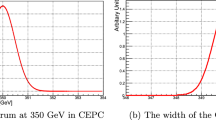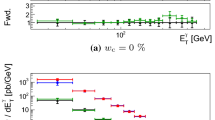Summary
An upper limit of the quark flux is derived by evaluating the detection efficiency of a quark telescope, taking into account losses due to the shower accompaniment arriving together with the quark. This is calculated under the assumption of quark production at rest in the c.m. system, and of two other models which permit only a more restricted energy transfer to the quarks. It is shown that, while in the c.m. production mode nearly all quarks produced are also detected, the others yield a much lower efficiency which decreases which increasing quark mass, and may be as low as 10−2 atm q=20m n. Thus the limit of 10−10 particles/cm2 sr s deduced from telescope experiments still permits the presence of a total quark flux of a few 10−9, or perhaps up to 10−8/cm2 sr s. Except for the results of the Ohio State group, all other flux measurements reported up to now seem to be compatible with this upper limit.
Riassunto
Si è calcolato un limite superiore del flusso di quark valutando l’efficienza di rivelazione di un telescopio per quark, tenendo conto dell’inefficienza dovuta all’accompagnamento dello sciame. Questo è calcolato sia nell’ipotesi che la produzione del quark avvenga a riposo nel baricentro, sia con l’uso di due altri modelli, che permettono un minor trasferimento di energia al quark. Si mostra che, mentre nel caso della produzione a riposo nel baricentro, praticamente tutti i quark prodotti sono pure rivelati, negli altri casi l’efficienza di rivelazione à molto inferiore e decresce al crescere della massa del quark fino ad essere dell’ordine di 10−2 per una massa del quarkm q=20m n. Per questo i limite di 10−10 particelle/cm2 sr s dedotto dagli esperimenti mediante telescopi permette ancora un flusso di quark prodotti di 10−9 o addirittura di 10−8 particelle/cm2 sr s. A parte il risultato del gruppo dell’Ohio State ogni altro limite di flusso finora pubblicato sembra essere compatibile con tale valore.
Реэюме
Выводится верхний предел потока кварков, оценивая зффективность кваркового телескопа, учитывая потери, свяэанные с ливневым сопровождением, попадаюшим в телескоп вместе с кварком. Этот верхний предел вычисляется при предположении, что рождение кварков происходит в покое в системе центра масс, и с помошью двух других моделей, которые допускают лищь минимальную передачу знергии кваркам. Покаэывается, что если в моде рождения в системе центра масс почти все рожденные кварки детектируются, то другие модели дают более ниэкую зффективность регистрации, которая уменьщается с увеличением массы кварка, и может быть меньще 10−2 приm q=20m n. Таким обраэом, предел 10−10 частиц/см2 стерад сек, полученный иэ телескопических иэмерений, еше допускает наличие полного потока кварков порядка нескольких единиц на 10−-9, или, воэможно, вплоть до 10−8 кварков/см2 стерад сек. За исключением реэультатов группы штата Огайо, все другие иэмерения потоков, которые сообшались до настояшего времени, по-видимому, согласуются с полученным верхним пределом.
Similar content being viewed by others
References
L. W. Jones:Proceedings of the XII International Conference on Cosmic Rays (Hobart, 1971).
Y. S. Kim andN. Kin: private communication (1971).
C. B. A. McCusker andI. Cairns:Phys. Rev. Lett.,23, 658 (1969);I. Cairns, C. B. A. McCusker, L. S. Peak andR. L. S. Wolcott:Phys. Rev.,186, 1394 (1969).
R. K. Adair andH. Kasha:Phys. Rev. Lett.,23, 1355 (1969).
H. Frauenfelder, U. E. Kruse andR. D. Sard:Phys. Rev. Lett.,24, 33 (1970).
D. S. Rahm andR. I. Louttit:Phys. Rev. Lett.,24, 279 (1970).
I. D. Cairns: Ph. D. Thesis, University of Sydney (unpublished) (1971).
A. S. Clark, R. D. Ernst, H. F. Finn, G. G. Griffin, N. E. Hansen, D. E. Smith andW. M. Powell:Phys. Rev. Lett.,27, 511 (1971).
W. E. Hazen:Phys. Rev. Lett.,26, 582 (1971).
W. T. Chu, Y. S. Kim, W. J. Beam andN. Kwak:Phys. Rev. Lett.,24, 917 (1970).
W. W. M. Allison, M. Derick, G. P. Hunt, J. D. Simpson andL. Voyvodic:Phys. Rev. Lett.,25, 550 (1970).
M. Dardo, G. Navarra, P. Penengo andK. Sitte:Proceedings of the VI International American Seminar on Cosmic Rays (La Paz, 1970);Nuovo Cimento,9 A, 319 (1972).
H. Faissner, M. Holder, K. Krisor, G. Mason, Z. Sawaf andU. Umbach:Phys. Rev. Lett.,24, 1357 (1970);A. Bohm, W. Diemont, H. Faissner, K. Krisor, K. Maull, Z. Sawaf andH. Umbach:Phys. Rev. Lett.,28, 326 (1972).
K. Greisen:Ann. Rev. Nucl. Sci.,10, 63 (1960).
K. Greisen:Progress in Cosmic Ray Physics, Vol.3 (Amsterdam, 1956).
B. Bosia, L. Briatore andK. Sitte:Proceedings of the VI Inter-American Seminar on Cosmic Rays (La Paz, 1970).
Author information
Authors and Affiliations
Rights and permissions
About this article
Cite this article
Bosia, G.F., Briatore, L. & Sitte, K. The upper limit of the quark flux. Nuov Cim A 12, 1025–1037 (1972). https://doi.org/10.1007/BF02747864
Received:
Published:
Issue Date:
DOI: https://doi.org/10.1007/BF02747864




